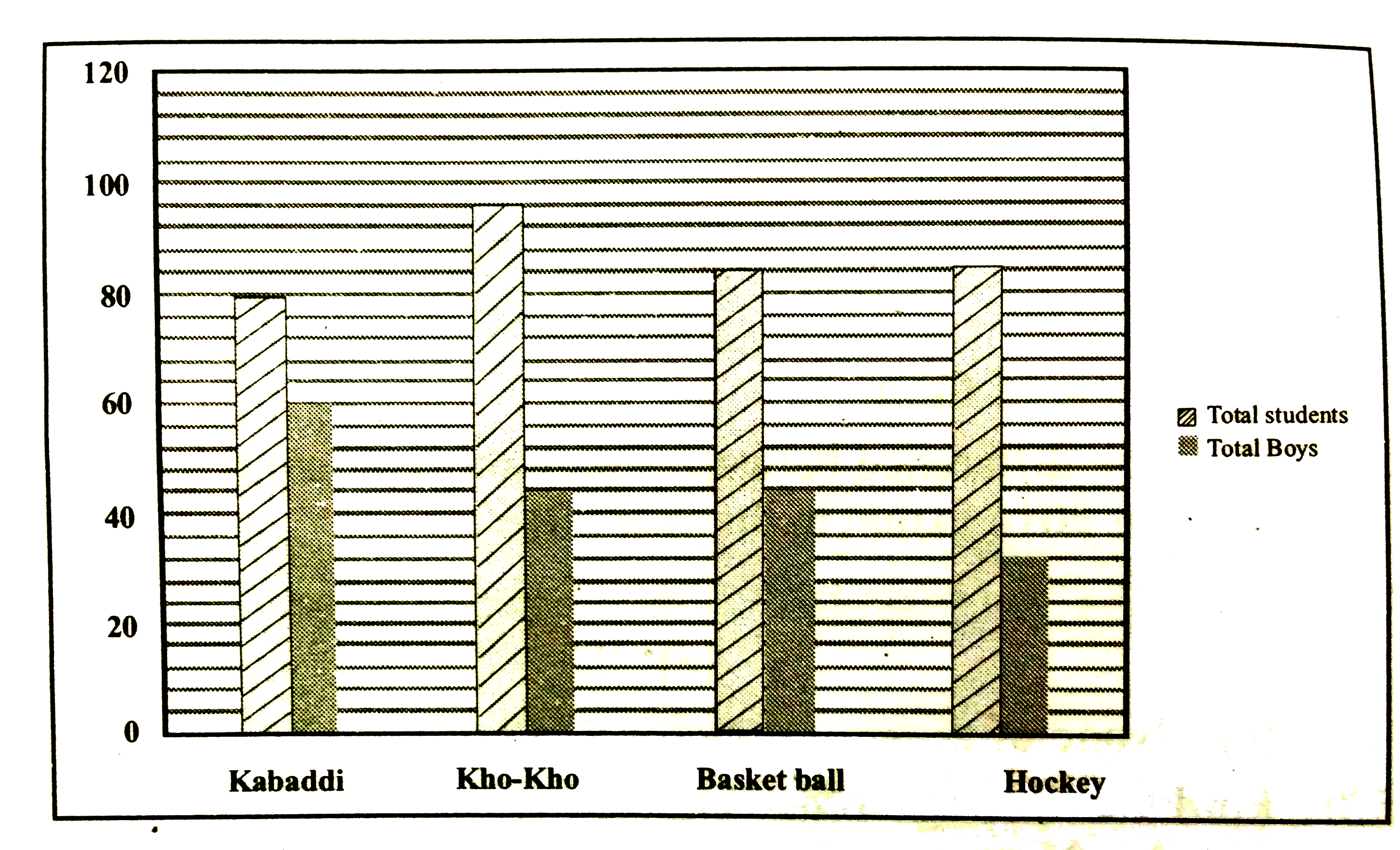Study the information carefully to answer the questions that follows. In an annual function, 504 children participated. The ratio of number of girls to the number of boys is 5:3 respectively. Out of the total girls, 20% participated in dance and remaining girls participated in solo song, group song and drama in the ratio of 2:3:4 respectively. Two -third of the total boys participated in group song and remaining boys participated in solo song and dance in the ratio of 4:5 respectively.
What is the difference between the number of boys and girls who have participated in dance ?
63
35
28
126
The correct Answer is:C
To solve the problem step by step, we will follow the information provided in the question and break it down systematically.
Step 1: Determine the number of girls and boys
We know that the total number of children is 504 and the ratio of girls to boys is 5:3.
1. Calculate the total parts in the ratio:
5+3=8 parts
2. Calculate the number of girls:
Number of girls=58×504=315
3. Calculate the number of boys:
Number of boys=38×504=189
Step 2: Calculate the number of girls participating in dance
Out of the total girls, 20% participated in dance.
1. Calculate the number of girls participating in dance:
Girls in dance=20% of 315=20100×315=63
2. Calculate the remaining girls:
Remaining girls=315−63=252
Step 3: Distribute the remaining girls among solo song, group song, and drama
The remaining girls participate in solo song, group song, and drama in the ratio of 2:3:4.
1. Calculate the total parts in the ratio:
2+3+4=9 parts
2. Calculate the number of girls in solo song:
Girls in solo song=29×252=56
3. Calculate the number of girls in group song:
Girls in group song=39×252=84
4. Calculate the number of girls in drama:
Girls in drama=49×252=112
Step 4: Calculate the number of boys participating in dance
Two-thirds of the total boys participated in group song.
1. Calculate the number of boys in group song:
Boys in group song=23×189=126
2. Calculate the remaining boys:
Remaining boys=189−126=63
Step 5: Distribute the remaining boys among solo song and dance
The remaining boys participate in solo song and dance in the ratio of 4:5.
1. Calculate the total parts in the ratio:
4+5=9 parts
2. Calculate the number of boys in solo song:
Boys in solo song=49×63=28
3. Calculate the number of boys in dance:
Boys in dance=59×63=35
Step 6: Calculate the difference between the number of boys and girls who participated in dance
1. Difference:
Difference=Girls in dance−Boys in dance=63−35=28
Final Answer
The difference between the number of boys and girls who have participated in dance is 28.
---
We know that the total number of children is 504 and the ratio of girls to boys is 5:3.
5+3=8 parts
Number of girls=58×504=315
Number of boys=38×504=189
Out of the total girls, 20% participated in dance.
Girls in dance=20% of 315=20100×315=63
Remaining girls=315−63=252
The remaining girls participate in solo song, group song, and drama in the ratio of 2:3:4.
2+3+4=9 parts
Girls in solo song=29×252=56
Girls in group song=39×252=84
Girls in drama=49×252=112
Two-thirds of the total boys participated in group song.
Boys in group song=23×189=126
Remaining boys=189−126=63
The remaining boys participate in solo song and dance in the ratio of 4:5.
4+5=9 parts
Boys in solo song=49×63=28
Boys in dance=59×63=35
1. Difference:
Difference=Girls in dance−Boys in dance=63−35=28
The difference between the number of boys and girls who have participated in dance is 28.
Topper's Solved these Questions
Similar Questions
Knowledge Check
Study the information carefully to answer the questions that follows. In an annual function, 504 children participated. The ratio of number of girls to the number of boys is 5:3 respectively. Out of the total girls, 20% participated in dance and remaining girls participated in solo song, group song and drama in the ratio of 2:3:4 respectively. Two -third of the total boys participated in group song and remaining boys participated in solo song and dance in the ratio of 4:5 respectively.
What is the approximate percentage of the girls participated in solo song out of all the total participants ?A11%B15%C6%D20%The ratio of the number of girls to the number of boys in a town is 90%. If the total number of boys and girls in the town is 190, how many girls are in the town?
A100B110C90D80What is the total number of students in a college ?
I. 75% of the total number of students are boys.
II. The ratio of number of girls to the number of boys is 1:3.A(A). If statement I alone is sufficient but statement II alone is not sufficient.B(B). If statement Il alone is sufficient but statement I alone is not sufficient.C(C). If each statement alone (either I or II) is sufficient.D(D). If statement I and Il together are not sufficient.
The boys and the girls in a school are in the ratio 7:4. If total strength of the school be 550, find the number of boys and girls.
View SolutionThere are 20 girls and 15 boys in a class.
What is the ratio of number of girls to the total number of students in the class?
View SolutionThere are 20 girls and 15 boys in a class.
What is the ratio of number of girls to the total number of students in the class?
View SolutionThe following bar graph shows the total number of students (Boys+Girls) and the total number of boyes who participated in different sports .

Find the difference between the number of boys participated in Kho-Kho with the number of girls participated in Basket ball ?
View Solution70% of the students in a school are boys and the number of girls is 504 find the number of boys in the school
View Solution
